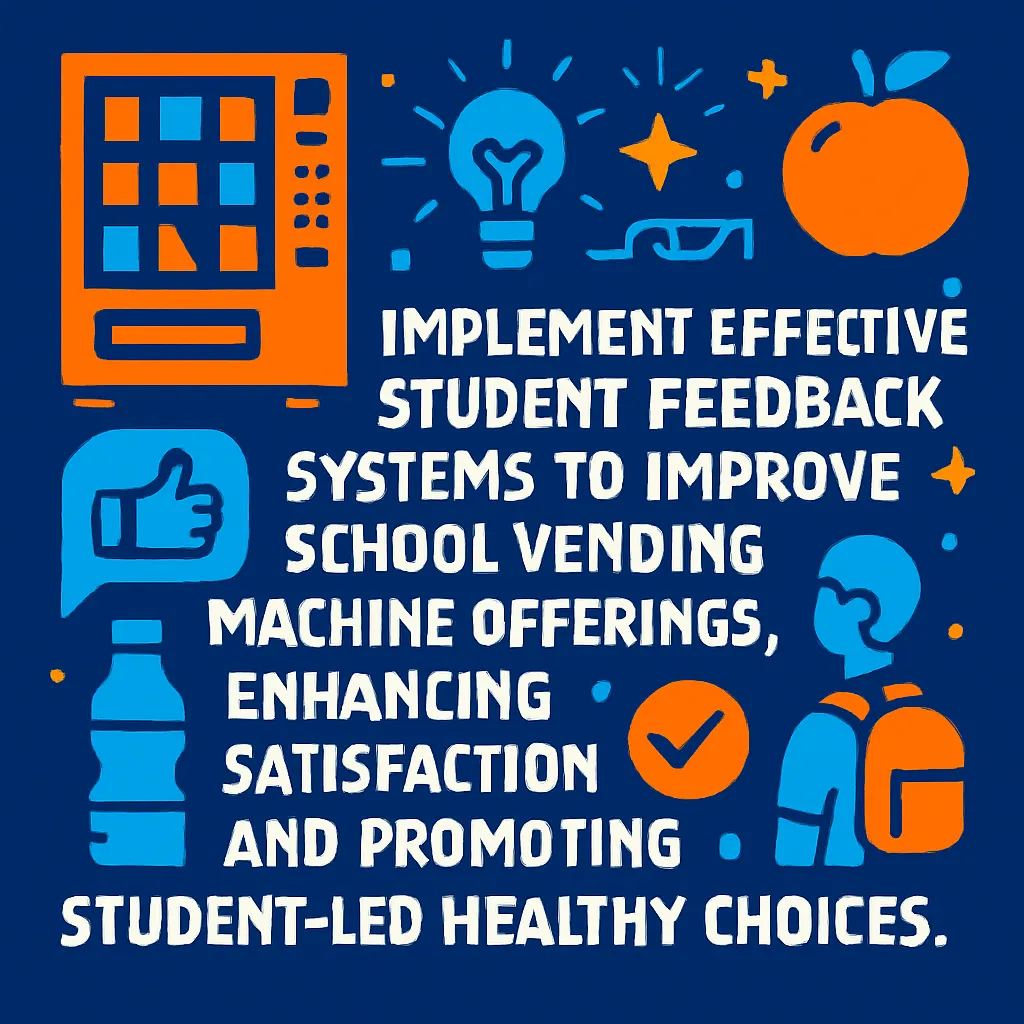Student Feedback Systems for School Vending
Implement effective student feedback systems to improve school vending machine offerings, enhancing satisfaction and promoting student-led healthy choices.
Back to Vending for Schools ResourcesImplement effective student feedback systems to improve school vending machine offerings, enhancing satisfaction and promoting student-led healthy choices.
Back to Vending for Schools ResourcesEngaging students in the vending selection process directly improves their satisfaction and encourages healthier eating habits within the school environment.
![]() Boosts student satisfaction and engagement with school services
Boosts student satisfaction and engagement with school services
![]() Directly influences healthier food and drink options based on student choice
Directly influences healthier food and drink options based on student choice
![]() Ensures vending selections align with current student trends and needs
Ensures vending selections align with current student trends and needs

In today's schools, vending machines are an integral part of providing convenient access to snacks and beverages. However, without direct input from the students they serve, these machines might not fully meet their needs or contribute positively to campus wellness. Implementing robust student feedback systems is crucial for ensuring vending selections are desirable, nutritious, and utilized effectively.
Students are the primary consumers of school vending machines, making their opinions invaluable. A well-designed feedback system allows schools to identify popular items, discover emerging trends, and address concerns about product quality or machine functionality. By actively involving students, schools can transform vending machines from mere snack dispensers into a dynamic service that genuinely caters to the student body. This participation also instills a sense of ownership and responsibility among students, encouraging them to make healthier choices when they feel their voices are heard.
There are multiple ways schools can gather student insights. Simple suggestion boxes placed near vending machines can be a starting point. More advanced digital methods, such as online surveys distributed via email or school portals, offer broader reach and easier data analysis. Some modern vending machines can even incorporate QR codes that link directly to feedback forms, allowing for immediate input after a purchase. Engaging student councils or wellness committees to lead discussions and surveys can also foster deeper engagement and more representative feedback. For schools investigating a range of options, reviewing a school administrator guide to vending can provide comprehensive strategies.
While student preferences are essential, schools also have a responsibility to promote healthy eating. Effective feedback systems can bridge this gap by asking specific questions about preferences for healthier alternatives or new nutritious product suggestions. For instance, if students request more fruit options or sugar-free drinks, schools can act on this while still adhering to nutritional guidelines such as those found in healthy snack policy for schools. This collaborative approach helps create a vending program that is both appealing and beneficial for student health. Understanding school-compliant vending options is also vital for successful implementation.
Collecting feedback is only the first step; acting on it is what truly demonstrates responsiveness. Schools should regularly review feedback, identify common themes, and work with vending operators to implement changes. Transparent communication about these changes is equally important. Announce new product additions based on student requests, explain why certain suggestions cannot be met (e.g., due to nutritional policies), and celebrate successes where student input led to positive improvements. This continuous loop of feedback, action, and communication builds trust and encourages ongoing participation.
Student feedback helps tailor vending offerings to their preferences, increasing usage and satisfaction, while also promoting healthier choices.
Schools can use surveys, suggestion boxes, student council discussions, online forms, and direct QR code feedback systems on machines.
Regularly, such as once per semester or at least annually, to ensure offerings remain current with student trends and preferences.
Absolutely. When students request healthier items, schools can use this data to stock nutritious snacks and beverages, aligning with wellness goals.
Challenges include ensuring a high participation rate, sorting through diverse suggestions, and balancing student desires with budget and nutritional guidelines.
By providing clear guidelines, specific questions, and examples of helpful feedback, schools can guide students to offer useful suggestions.
Yes, offering anonymity can encourage more honest and candid responses from students, especially regarding unpopular items or service issues.
Schools should inform students through announcements, newsletters, school websites, or special signs near vending machines to demonstrate their responsiveness.
Technology can enable instant feedback via QR codes, online polling, and app-based suggestion platforms, making the process more efficient and engaging.
Operators gain valuable insights into product demand, helping them optimize inventory, reduce waste, and ultimately increase sales and student satisfaction.